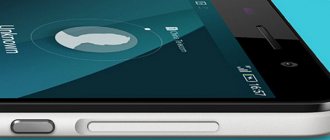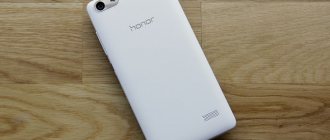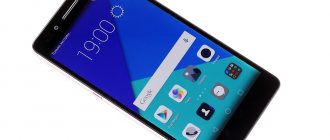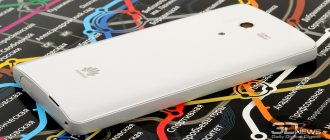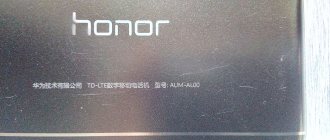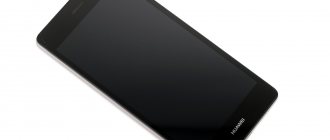Appearance
The smartphone body is completely plastic. There is not an ounce of metal here. The manufacturer proudly states that the entire surface is 100% glossy. I don’t know if this can definitely be considered a virtue. In my opinion, gloss is beautiful, but completely impractical. Fingerprints, scratches - all this spoils the appearance of the device over time.
Back cover Huawei Honor 3C Lite
The front side of the smartphone is made of black plastic, and the back cover is made of white. At the front at the bottom there are standard system control keys. It’s good that they are placed separately and do not eat up the display space.
However, the buttons are not backlit. In the dark you have to navigate either by memory or by point and click to determine where to press. It is not comfortable.
Control buttons
Above the screen there is a speaker grid, a light indicator for various events, a front camera, as well as proximity and light sensors.
Earpiece and front camera
The ambient light sensor works quickly and quite correctly.
The side frames are very wide (approximately 4.5 mm), and given the rather thin thickness of the smartphone (9.4 mm), they could be made thinner.
If we're talking about dimensions, then in the table below you can compare the device with its main competitors.
| Length | Width | Thickness | Weight | |
| Huawei Honor 3C Lite | 142,2 | 72,3 | 9,4 | 156 |
| Asus Zenfone 5 | 148,2 | 72,8 | 10,34 | 145 |
| LG G2 mini | 129,6 | 66 | 9,99 | 121 |
| Lenovo A859 | 142 | 72,5 | 9,2 | 162 |
On the back cover there is a camera eye, which protrudes slightly above the surface of the case. This is strange, since, I repeat, the thickness of the phone is far from small and the photosensor could easily fit into the body of the device.
Rear camera and flash
Next to the camera there is an LED flash, a microphone hole, and closer to the bottom edge we see the main speaker grille. Its location is not very good, since on a relatively flat and soft surface (for example, on a sofa) the sound will be noticeably muffled. However, this is a design nuance of almost every second modern smartphone. Manufacturers are still too lazy to fit speakers into the side frames.
Speaker
On the right side there are volume buttons and a power key. The button travel is small but clear. The left side is devoid of any elements.
Sides of the smartphone
There is only an audio port on top, and the bottom edge is occupied by a microphone hole and a Micro USB connector.
The ergonomics of the device did not disappoint. Despite the smooth surface, the device fits well in the hand, much better than its metal counterparts.
The device can be easily controlled with one hand.
Of course, it will not be easy to reach the opposite corner of the interface with your thumb, but the dimensions allow you to type messages on the go, navigate through the menu, without intercepting the device.
Design
The device is quite large, because the display diagonal is 5.5 inches, in addition, it allows for the use of two SIM cards of standard and MicroSIM formats, and yet it is comfortable to hold in your hand.
Externally, the smartphone looks very nice: rounded edges, metallic edging, a certain minimalism.
So, on the smartphone itself, the company name is located only above the display, next to the speaker and the 5MP front camera.
At the bottom there are the “return”, “home” and “menu” buttons.
On the back panel there is a pattern of vertical stripes, on top of which is a discreet company logo, a 13MP main camera, a flash, a second microphone and a speaker.
The connectors are arranged as standard: at the top is a jack for a headset and headphones, at the bottom is a connector for microUSB, on the right is a volume button and a power key.
It is worth noting that Huawei Honor 3X is assembled really well: it does not creak or bend under compression and pressure.
Display
It uses a 5-inch IPS matrix with a resolution of 1280 x 720 pixels. The pixel density of 294 ppi is generally sufficient for a smooth and comfortable picture. Many of the phone's competitors have a slightly lower resolution: 960 x 540 pixels, and this is already critical for 5 inches.
Honor 3C Lite screen in the sun
There is an oleophobic coating on the surface of the screen, but it is not very effective. What material is used at the base of the protective panel is not specified. It feels like plastic.
Viewing angles, color richness and other parameters are at a good level. The display is one of the main advantages of the hero of the review and the photo below confirms this (clickable):
Interestingly, in the Gallery, images cannot be opened in full screen, even in slide show mode. This does not apply to games and other full-screen programs.
Screen
Like many mid-priced flagships, Honor 3X does not boast a FullHd display. Of course, when a 5.5-inch screen has a 1280x720 resolution with a density of 267ppi, it's disappointing. The contrast is low and the colors are not bright enough, but not bad.
And of course, how can we not mention the recognition of 10 touches! Of course, it was difficult to find a place on the screen for all ten, but I managed, albeit after several training sessions. Unfortunately, I can’t imagine a situation in which I need all ten fingers on a smartphone.
The viewing angles are wide, and in bright sunlight, you can safely view photos and videos and read text on the screen without squinting or looking for shadows. The screen sensor also responds to touches with gloves, which is a significant plus. Some more well-known smartphone manufacturers neglect even this.
Technical characteristics of Huawei Honor 3C Lite:
| Huawei Honor 3C | Huawei Honor 3C Lite | |
| CPU | MediaTek MT6582 with quad cores up to 1.3 GHz | MediaTek MT6582 with quad cores up to 1.3 GHz |
| Video accelerator | Mali 400MP (400 MHz) | Mali 400MP (400 MHz) |
| RAM | 2 GB | 1 GB (on a clean system 495 MB) |
| Built-in memory | 8 GB | 16 GB (12.61 GB actually available) |
| Memory card support | Micro SD (up to 32 GB) | Micro SD (up to 32 GB) |
| Display | IPS 5'', 1280 x 720 (294 ppi) | IPS 5'', 1280 x 720 (294 ppi) |
| Main camera | 8 MP | 8 MP |
| Front-camera | 5 MP | 2 MP |
| Battery | 2300 mAh | 2000 mAh |
| OS | Android 4.2.2 / Emotion 2.0 | Android 4.4.2 / Emotion 2.0 |
| cellular | 2G (900/1800/1900 MHz), 3G (HSPA+), 2 Micro-SIM | 2G (900/1800/1900 MHz), 3G (HSPA+), 2 Micro-SIM |
| Interfaces | Bluetooth 4.0, Wi-Fi (b/g/n), MicroUSB (no OTG), GPS/GLONASS | Bluetooth 4.0, Wi-Fi (b/g/n), MicroUSB (no OTG), GPS/GLONASS |
| Sensors | Light sensor, proximity, accelerometer, gyroscope, compass | Light sensor, proximity, accelerometer, compass |
| Dimensions | 139.5 x 71.4 x 9.2 mm, 140 g | 142.2 x 72.3 x 9.4 mm, 156 g |
The processor is created using 28-nanometer technology, and is based on 4 cores with a frequency of up to 1.3 GHz each.
There are several differences from the regular 3C version: the Lite model has:
- 1 GB of RAM, versus two in the older version,
- less capacious battery 2000 mAh,
- front camera is only 2 megapixels (its brother is 5 megapixels)
- 16 GB of memory for data storage, versus eight in a more advanced solution. Of course, the dimensions of the devices are also slightly different.
It's sad that the OTG protocol is not supported for connecting third-party devices (flash drives, keyboards, etc.), and there is also no NFC. For devices of this class, this is still normal practice, so this should not be taken as a disadvantage.
The device has support for two SIM cards, one of which is responsible for 2G communications, the other for 3G. The form factor is normal - Micro-SIM. I was able to conduct a conversation from two cards at once, which suggests the use of either two independent radio modules, or the use of some special technology.
It’s interesting that the manufacturer got confused and presented the results of laboratory tests of his brainchild. For example, the power button of a smartphone can withstand 200,000 presses, the USB port can withstand 10,000 connection-disconnection cycles, and the device can fall up to 200 times and no more. Please keep this in mind! The official website of the company’s store also contains other interesting indicators. If you wish, you can view them here.
The performance of the device is quite sufficient for ordinary tasks.
The shell is well-debugged, thoughtfulness and rare slowdowns are kept to a minimum, but occasionally you still come across them. The system as a whole is very stable.
In games you should not count on high graphics settings. Works on medium and ok.
Finally, I will present the results of synthetic tests.
⇡#Iron and communications
In terms of hardware, Huawei Honor 3 is a copy of the fashionable Huawei Ascend P6. The same HiSilicon K3V2E processor, the same 2 GB of RAM and 8 GB of flash storage with a slot for MicroSD cards. The processor is not very fast by today's standards.
Of course, four Cortex-A9 cores are generally better than the same number of Cortex-A7 cores. But the “customized” architecture of Qualcomm Krait, even in the previous generation version, handles K3V2E without straining. Of course, comparing expensive flagship smartphones with the affordable Honor 3 is not entirely correct, but we do this in order to show: not all quad-core chips are equally useful.
The same can be said about the graphics. Compared to those video adapters that are equipped with cheap chips from MediaTek, the Vivante GC1000 looks pretty good. But put it against a serious opponent - at least against last year's Adreno 320, not to mention the current Adreno 330 - and it has no chance.
As for the radio module, Huawei decided not to spoil the buyer with the latest achievements of the cellular communications industry - and even the penultimate ones did not bother them. Honor 3 is equipped with the well-deserved Intel XMM6260 platform (for example: the same chipset was installed in the Samsung Galaxy S2). There is no talk of LTE support, and 3G is far from the latest version: speeds of up to 21 Mbit/s “down” and 5.76 Mbit/s “up” are available.
MicroSD and microSIM card slots are located in the battery compartment
The range of bands is also scanty: although all four world bands are supported for 2G, for 3G there are only two - 900 and 2100 MHz. This will be enough for Russia, China and Europe, but if you often visit the USA, then Honor 3 will not suit you - there you are guaranteed to be left without mobile data transfer. It is worth noting that this is typical for Chinese smartphones: the exact same radio module with support for exactly the same frequencies is installed in the significantly more expensive Meizu MX3.
GPS reception a minute (left) and a minute and a half (right) after a cold start, balcony of an apartment building
Against this background, it was unexpected and pleasant to see that Honor 3 supports not only the mandatory GPS, but also GLONASS. That is, the navigation module in the smartphone is quite new and advanced; it can use two satellite navigation systems at once, thanks to which orientation on the ground is really fast. Otherwise, everything is average: there are Bluetooth 3.0 and Wi-Fi 802.11b/g/n adapters on board, but, of course, there is no infrared port or NFC module; There is also no question of supporting the fashionable 802.11ac - however, you shouldn’t worry too much about it.
Camera
The rear camera is based on an 8 megapixel matrix with a 2.0 lens aperture and five optical lenses. All these are big words, which, in theory, should have a positive effect on the quality of the final images. In reality this is not the case.
There is no autofocus even though the object capture frame jumps in the viewfinder. And in general, the photos are of very low quality.
The size of the pictures is 3264 x 2448 pixels and they look good only on a phone screen.
100% crop:
Additional shooting modes include support for HDR images, creating panoramas, installing filters, burst shooting, skin retouching and less significant options.
The front photo module has a resolution of 2 megapixels, and the output photos are 1600 x 1200 pixels. The front camera is only suitable for video calls. The quality of the images is again average or slightly lower.
Much the same can be said about video shooting. Yes, the video resolution is 1920 x 1080 pixels, but the 3GP format and the picture do not inspire optimism. One of the examples is below.
Preparation
Before starting the firmware, you need to make sure that the phone has at least 70% battery charge. It wouldn’t hurt to make a backup copy of your data; for example, you can copy all the data from your phone to a memory card or PC. This will protect the data from accidental deletion. You need to download all the necessary files for the firmware. In particular, download the SP Flash Tool utility (you can download it from the official website of the product).
Unpack SP Flash Tool to the root of the “C:/” drive. In addition, you need to download and unpack the official “B112” firmware (it is important to pay attention to the fact that there are no Russian letters in the folder). Regarding the USB cable, it is worth saying that it is fundamentally important to connect it to the computer directly through the motherboard port (you cannot use any adapters, hubs or ports on the front panel of the system unit).
During the installation of the firmware, you cannot use the phone, turn on or reboot the device yourself.
Multimedia
The main speaker is loud, but, of course, not a record. It will be difficult to miss a call on a noisy street, although the streets are different. But the quality of playback through the speaker is far from ideal. There is no semblance of low and, in principle, mid frequencies here. The music whistles, tinkles and strums - it’s not very pleasant to listen to.
Keep calm! The sound quality through the headphones is absolutely fine. The volume and sound processing are quite consistent with the same iPhone 5. In addition, the parameters include a 5-band equalizer, the ability to adjust bass, sound volume, and so on.
The conclusion is this: 3C Lite is definitely suitable for those who like to listen to music through headphones.
The list of supported audio formats is as follows: MP3, MIDI, AMR, AWB, AAC, FLAC, APE, OGG, WAV, WMA.
The device is capable of playing video files such as: MP4, MKV, WMV, AVI, 3GP, M4V, FLV, WEBM, MOV.
Smartphone battery
The lithium-ion battery is removed from under the back cover and has a capacity of 2000 mAh. This is more than enough for the installed hardware. With very moderate use, the device can work on a single charge for up to five days in a row.
With active use of the device, it will delight the owner with two days of stable operation. Only games or watching movies online can kill your battery in a day. In other words, the smartphone does not need to be charged every day, and this is perhaps one of the main advantages of any mobile device.
Software chips
The proprietary Emotion 2.0 shell with its own features and bells and whistles is installed on top of the Android OS.
One of the main features of the system is that all applications are placed on desktops. The latter can be added and configured at your discretion - in general, everything is as always.
For people who have recently joined high technology, there is a special Simple mode
. Program icons on desktops become more visual and easy to use. However, other parts of the system (phone, contacts, messages) do not change in any way.
Additional applications available include FM radio, a flashlight, a file manager, a voice recorder, a set of services from IVI, and more.
The notification shade is divided into two parts: the first displays a list of various events, the second with all the quick settings of the phone is hidden under a small icon in the upper right corner.
Working with SIM cards comes down to setting color profiles, individual ringtones, data transfer settings, and so on. The choice of SIM card occurs immediately before making a call or sending a message. There is no separate key for this.
Calls and multimedia
The operation of two SIM cards is implemented on the basis of one radio module - both cards are available in standby mode; during a conversation, the second card is turned off. Traditionally, in the settings the default card operation parameters are set; the dialer and SMS have separate call and message keys for different cards, which is quite convenient. You cannot assign separate ringtones and messages to different SIM cards.
The volume of the ringing and conversational speakers is slightly above average; in a noisy environment it may not be enough. The sound from both speakers is clear and pleasant, without distortion. Considering its size and weight, the vibration alert is relatively powerful. When talking in hands-free mode, the speaker volume is enough for comfortable communication, but the sensitivity of the microphone in this mode is not high, you have to raise your voice, under normal conditions there are no problems with this. During a call, you can quickly access your notes to jot down some important information. Recording a conversation is not provided by standard means.
According to subjective feelings, compared to smartphones on previous generations of MediaTek chipsets, the quality of music playback in headphones has improved slightly, but the maximum volume is low; in most cases, a volume level close to the maximum was comfortable. There is a built-in DTS equalizer with several presets that works in players, games for headphones and external speakers.
The built-in video player of Honor 3X plays videos in popular formats, except for AC3 audio tracks. The smartphone copes well with 4K video playback; this still remains the prerogative of devices with top-end SoCs from Qualcomm.
Playing video files
| Codec\Name | UltraHD4K.mp4 | Neudergimie.mkv | GranTurismo.mp4 | Spartacus.mkv | ParallelUniverse.avi |
| Video | MPEG4 Video (H264) 3840×2160 29.92fps, 19.4 Mbit/s | MPEG4 Video (H264) 1920×816 23.98fps | MPEG4 Video (H264) 1920×1080 60fps, 19.7Mbit/s | MPEG4 Video (H264) 1280×720 29.97fps | MPEG4 Video (H264) 1280×536 24.00fps 2726kbps |
| Audio | AAC 44100Hz stereo 124kbps | MPEG Audio Layer 3 44100Hz stereo | AAC 48000Hz stereo 48kbps | Dolby AC3 44100Hz stereo | MPEG Audio Layer 3 44100Hz stereo 256kbps |
| Player\MXVideoPlayer | UltraHD4K.mp4 | Neudergimie.mkv | GranTurismo.mp4 | Spartacus.mkv | ParallelUniverse.avi |
| Video | Yes Yes | Yes Yes | Yes Yes | Yes Yes | Yes Yes |
| Audio | Yes Yes | Yes Yes | Yes Yes | No Yes | Yes Yes |


